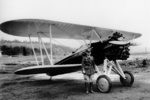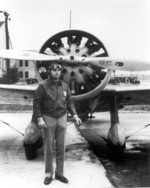Ira Eaker
| Surname | Eaker |
| Given Name | Ira |
| Born | 13 Apr 1896 |
| Died | 6 Aug 1987 |
| Country | United States |
| Category | Military-Air |
| Gender | Male |
Contributor: C. Peter Chen
ww2dbaseIra Clarence Eaker was born in Field Creek, Texas, United States to a tenant farmer. After attending Southeastern State Teachers College in Durant, Oklahoma, United States, he joined the US Army in 1917, becoming a reserve second lieutenant in the infantry. As a member of the 64th Infantry Regiment, he was deployed to France during WW1. He received a commission in the Regular Army later in Nov 1917. In Mar 1918, he was placed on detached service to receive flight training at Austin and Kelly Fields in Texas. In Oct 1918, upon completion of flight training, he was assigned to Rockwell Field, California, United States. In Jul 1919, he was transferred to Fort Mills at Corregidor in the Philippine Islands, where he served with the 2nd Aero Squadron based. In Sep 1920, he took on staff roles in Manila, Philippine Islands. In Jan 1922, he was transferred to Mitchel Field, New York, United States as the commanding officer of the 5th Aero Squadron. While in New York, he studied law at Columbia University, but he did not complete a degree. In Jun 1924, he became the executive assistant in the Office of Air Service at Washington DC, United States. Between 21 Dec 1926 and 2 May 1927, he participated in the 35,200-kilometer Pan American Goodwill Flight around South America, winning one of the Mackay Trophies at its completion. After some time at the Office of the Assistant Secretary of War in Washington DC, in Sep 1926, he became the operations and line maintenance officer at Bolling Field, which was also in Washington DC. In Jan 1929, flying the US Army aircraft "Question Mark" as the chief pilot, the crew of five broke the flight endurance record and won Distinguished Flying Cross medals; the mission commander was Major Carl Spaatz. In 1934, he received a Bachelor of Arts degree in journalism from the University of Southern California. Later in that year in Oct 1934, he was transferred to March Field, California to command the 34th Pursuit Squadron of the 17th Pursuit Group. In the summer of 1935, he served with the US Navy aboard the carrier USS Lexington during the maneuvers in the Hawaii Islands and off Guam, Mariana Islands. In Aug 1935, he enrolled at the Air Corps Tactical School at Maxwell Field, Alabama, United States. In Jun 1936, he enrolled in the Command and General Staff School at Fort Leavenworth, Kansas, United States; he completed the studies at the Command and General Staff School in Jun 1937. In Nov 1940, he became the commanding officer of 20th Pursuit Group at Hamilton Field, California. In 1941, he was promoted to the rank of colonel.
ww2dbaseAfter the United States entered WW2, Eaker was promoted to the rank of brigadier general in Jan 1942 and was assigned to organize the VIII Bomber Command. The command was based in Britain, and he studied British bombing operational experience against targets on continental Europe in the past two years of war. In Dec 1942, he assumed command of the force he organized, which was christened as the Eighth Air Force. In this role, he was an advocate for his superior General Henry "Hap" Arnold's daylight bombings strategy, even after the British had concluded day time attacks to be too costly, despite Arnold's initial failure to provide him an adequate number of long range fighters to escort the bombers for missions over Germany. He personally participated in the first American B-17 Flying Fortress bombing mission against Rouen, France in Aug 1942. On 6 Sep 1943, as continuously pressured by Arnold, he launched a large raid against Stuttgart, Germany without long range fighter escort, and as a result 45 bombers were lost; in the subsequent weeks, Eaker launched only missions against German targets in France, while he was finally able to convince Arnold to divert more long range fighters to Britain. When General Dwight Eisenhower was named the Supreme Allied Commander in Europe in Dec 1943, Eisenhower requested Lieutenant General James Doolittle to take over the Eighth Air Force, and Arnold agreed without hesitation; this would place a strain in the working relationship between Eaker and Arnold, and Eaker would remain bitter about what he felt as a betrayal for the rest of his life.
ww2dbasePromoted to the rank of lieutenant general, Eaker was relegated to head the Mediterranean Allied Air Forces as its commander-in-chief. Although he continued to make critical decisions in the Allied war effort in Southern Europe, with the invasion of France in Jun 1944 his theater was largely regarded as a sideshow. He departed from Italy in Apr 1945 as he was named the Deputy Commander of the US Army Air Forces and Chief of the Air Staff.
ww2dbaseEaker retired from the US Army in 1947, and was given the rank of lieutenant general in the retired list of the newly established US Air Force in the following year. He was a vice president of Hughes Tool Company and Hughes Aircraft between 1947 and 1957, and a vice president with Douglas Aircraft between 1957 and 1961. Between 1962 and 1982, he wrote a weekly column on military affairs for the newspaper San Angelo Standard Times (of San Angelo, Texas, United States), which was syndicated to many other newspapers across the country. In 1970, he was inducted into the National Aviation Hall of Fame in Dayton, Ohio, United States. On 10 Oct 1978, he was awarded the Congressional Gold Medal. In 1985, via a special legislation by the US Congress signed by President Ronald Reagan, he was promoted to the rank of general in the retired list of the US Air Force. He passed away in 1987 at Malcolm Grow Medical Center on the grounds of Andrews Air Force Base in Maryland, United States. He now rests at Arlington National Cemetery, Virginia, United States.
ww2dbaseSources:
Robert J. Mrazek, To Kingdom Come
Wikipedia
Last Major Revision: Aug 2011
Ira Eaker Interactive Map
Photographs
 |  |
Ira Eaker Timeline
| 13 Apr 1896 | Ira Eaker was born in Field Creek, Texas, United States. |
| 15 Nov 1917 | Ira Eaker, until this point a second lieutenant in the reserve, received a commission in the Regular Army of the United States. |
| 1 Jul 1920 | Ira Eaker was promoted to the rank of captain. |
| 21 Dec 1926 | Ira Eaker started the 35,200 km journey around South America in the Pan American Goodwill Flight in an OA-1 float plane. |
| 2 May 1927 | Ira Eaker completed the 35,200 km Pan American Goodwill Flight around South America, winning the one of the Mackay Trophies. |
| 1 Jan 1929 | Ira Eaker served as the chief pilot aboard the aircraft "Question Mark" on a quest to break the endurance flight record. |
| 7 Jan 1929 | Ira Eaker completed a 7-day flight aboard "Question Mark", breaking the endurance flight record. He and the entire crew won Distinguished Flying Cross medals for this feat. |
| 3 Jun 1936 | Ira Eaker took off from New York, United States on an attempt of the blind flight across North America. |
| 7 Jun 1936 | Ira Eaker completed the first blind flight from New York to Los Angeles, making this the first North American transcontinental flight using only instruments. |
| 20 Feb 1942 | A Douglas DC3 aircraft of the USAAF landed at RAF Hendon bringing Brigadier General Ira Eaker and six of his fellow officers; their orders were to prepare the way for the entry of the US Army Air Force into the "European Theatre of Operations". |
| 5 May 1942 | Ira Eaker was made the commanding officer of US Eight Bomber Command in Britain. |
| 17 Aug 1942 | Ira Eaker personally participated in the first American B-17 bombing mission against a continental European target, Rouen, France. |
| 1 Dec 1942 | Ira Eaker was named the commanding officer of the US Eighth Air Force in Britain, replacing Carl Spaatz. |
| 15 Jul 1943 | Secretary of War, Henry Stimson, Lt. General Jacob Devers, commander of US Army Air Forces in Europe, Maj. General Ira Eaker, commander of the Eighth Air Force, and several Brigadier generals visited RAF Thurleigh. Secretary Stimson personally present the Congressional Medal of Honor to Staff Sergeant Maynard “Snuffy” Smith for his heroic actions on 1 May 1943. |
| 2 Jun 1944 | US suttle-bombing between Italy and the USSR (Operation Frantic) began. Under command of Lieutenant General Ira C Eaker, 130 B-17s, escorted by 70 P-51s, bombed the railway marshalling yard at Debreczen (Debrecen), Hungary and landed in the Soviet Union; the B-17s at Poltava and Myrhorod, the P-51s at Pyriatyn. 1 B-17 was lost over the target. |
| 24 Sep 1944 | US Ambassador to the United Kingdom John Winant met with US Army Air Forces generals Carl Spaatz and Ira Eaker to discuss the possibility of conducting another major supply drop for resistance fighters in Warsaw, Poland. They concluded that similar missions should not be conducted due to the closure of US bases in the Soviet Union (the closure was planned for 5 Oct 1944), the shortening of daylight hours, and the rate of aircraft loss. |
| 30 Apr 1945 | Ira Eaker was named deputy commander of the Army Air Forces and chief of the Air Staff. |
| 31 Aug 1947 | Ira Eaker retired from the US Army. |
| 29 Jun 1948 | Ira Eaker was given the rank of lieutenant general in the retired list of the newly established United States Air Force. |
| 10 Oct 1978 | Ira Eaker was awarded the Congressional Gold Medal. |
| 26 Apr 1985 | Ira Eaker was promoted to the rank of general in the retire list of the US Air Force as the result of a special legislation of the US Congress. |
| 6 Aug 1987 | Ira Eaker passed away at Malcolm Grow Medical Center on the grounds of Andrews Air Force Base in Maryland, United States. |
Please consider supporting us on Patreon. Even $1 per month will go a long way! Thank you. Please help us spread the word: Stay updated with WW2DB: |
» Bombing of Hamburg, Dresden, and Other Cities
» Operation Frantic
Ship(s) Served:
» Lexington (Lexington-class)
Related Books:
» To Kingdom Come
- » 1,171 biographies
- » 337 events
- » 44,911 timeline entries
- » 1,244 ships
- » 350 aircraft models
- » 207 vehicle models
- » 376 weapon models
- » 123 historical documents
- » 261 facilities
- » 470 book reviews
- » 28,520 photos
- » 365 maps
George Patton, 31 May 1944